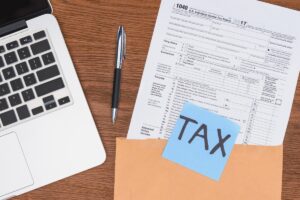Property taxes proration during Illinois transactions can be confusing. Meeting at the closing table to ensure fair payment by tax proration can have you asking why tax proration exists in the first place.
In 1930, during the Great Depression, many people were having trouble paying their taxes. So, Cook County, Illinois gave people a year break from paying their taxes. That held the property tax year back 12 months. This is the reason why property tax is paid in arrears today.

Hiring the right professionals to help, may help you understand the tax proration process. Here is an in-depth, easy-to-understand guide to tax prorations.
Additional Read: Tips And Tricks For Saving On Property Taxes
How Tax Prorations Work
Property tax proration is how property taxes are split, to ensure that the seller and buyer are only paying for the specific time that they own the property.
As the introduction stated, in Illinois, property tax is paid in the arrears. This means the seller of the property is required to pay taxes from up to, but not including the date of the transfer. The buyer is then responsible for property tax payments starting from the date of the transfer onwards.
Imagine the seller has paid property taxes a year in advance. At the time of sale, the buyer must credit a prorated portion of those taxes. The proration covers the remaining days of the tax year in which the buyer owns the home. These funds are paid to the seller.
The Tax Proration Process
It is vital to remember to address property tax and other prorations in the sales contract. If you do not, you could end up paying property tax and other fees for a time when you did not occupy the property.
Your attorney, real estate professional, or mortgage banker completes the proration calculations at closing. They then determine the amount of property taxes that the seller and buy are each supposed to pay.
The property tax year is not the same as a standard calendar year. The tax year starts on July 1st of one calendar year, ending on July 1st of the following year. For example, the property tax year as this article is written began on July 1st, 2020, and will end on July 1st, 2021.
In Illinois, property taxes are paid one year backward, in two installments.
For example – the first installment of a 2020 property tax bill was not payable until March of 2021. The second installment of 2020 is not due until August of 2021.
Because of this, when anyone buys real estate in Illinois, they inherit a tax bill that originated before they closed on the property.
This is a major part of the huge confusion behind tax proration, and knowing how much taxes should be paid by both the seller and the buyer.
Calculating How Much Property Tax Should Be Paid
The mathematics behind calculating property tax is usually completed by an accountant or attorney at the time of closing. We strongly recommend hiring a mortgage professional for this task.
If you want to calculate property tax proration yourself, we are providing you with this information so you can be aware of the process.
You can use a property tax proration calculator if math is not your strongest suit. But, we have tried to simplify the calculations as much as possible.
Step 1
Start by finding out the total amount of property tax for the property during that tax year. To do this, the seller needs to produce a copy of the tax bill. Keep that number handy.
Step 2
After that, you should be able to calculate the number of days in the tax year that the seller has owned the home. This includes the day before the sale date. It does not include the sale date itself.
For example, if the sale is closed on December 1st, the last day that the seller pays taxes is November 30th.
Step 3
Once you know the number of days that the seller has owned the home, divide that number by 365.
This will give you the percentage of the property tax year that the seller still owned the property.
Step 4
Get the amount from step 1 – the total amount of property tax. Now get the percentage from step 3 – the percentage of the property tax year that the seller owned the property.
Multiply those two numbers. The amount produced is the amount of taxes that the seller should have paid by the time of closing.
If that amount has not been paid, the seller must reimburse the buyer in that amount.
How to Calculate the Tax Credit Amount
Step 1
Find out the total amount of property tax for the property during that tax year. You can do this by retrieving a copy of the tax bill from the seller. Keep that number handy.
Step 2
Once you have the number of days that the seller has owned the home, divide that number by 365.
This number is the percentage of the property tax year that the seller still owned the property.
Step 3
Find the amount from step 1 – the total amount of property tax.
Now get the percentage from step 2 – the percentage of the property tax year that the seller owned the property.
Subtract that figure from the total property tax bill. That amount is the prorated amount that the buyer is required to pay at closing.
Tax Proration Amount in Closing
After the calculations are completed at closing, the prorated property tax amount is placed on the closing statements.
If the seller has paid property taxes in advance, the proration will appear as a credit for the seller and debit from the buyer.
At closing, take a look at the credit and debit amounts for your prorations to check which direction the taxes are paid from.
Find Out More by Contacting A and N Today
A and N Mortgage has some of the most acclaimed mortgage consultants in Chicago. We understand the tax proration process here in Illinois. Our team is happy to assist you in finding qualified attorneys to help you through what could be an otherwise difficult process.
We can help you navigate the complexities of tax proration. We’re here to support you as you complete the relevant paperwork.
You can contact us to make your property closing process as seamless and worry-free as possible.
A and N Mortgage Services Inc, a mortgage banker in Chicago, IL provides you with high-quality home loan programs, including FHA home loans, tailored to fit your unique situation with some of the most competitive rates in the nation. Whether you are a first-time homebuyer, relocating to a new job, or buying an investment property, our expert team will help you use your new mortgage as a smart financial tool.







